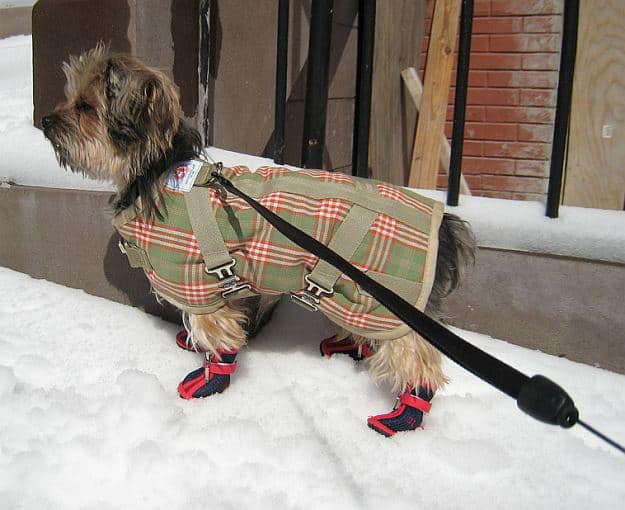
Winter Booties for Buster
Cold weather woes for doggy toes! If you live in a city where it gets cold in the winter, the salt they spread on the sidewalks to prevent and melt ice will burn the pads of a dog's feet. There are ice-melting chemicals used instead of or alongside salt --- like magnesium and calcium chloride --- which can also irritate a dog's feet. In addition, when you get home and your dog licks his feet he can get an upset stomach from ingesting those chemicals.
Dog booties can be great in the winter even if your dog does not have especially delicate feet because the products used on sidewalks to melt the ice and snow really can cause misery for your dog. The best protective action you can take in any wintry city is to get a set of dog booties. Those dogs that live in the country have a different challenge: the ice balls I've written about previously, that can form in between the toes and paw pads of longer haired dogs and can cause pain, limping, and even lameness. Those dogs need booties in harsh weather just as much as their city cousins.
One problem is that many of the dog boot designs are flawed. They don't take into account how a dog's foot and leg come together and the mechanics of how they move. Some are so poorly designed that they fall off before a dog gets out of the house! My book The Dog Bible mentions a few companies that have a user-friendly dog boot design --- and even one company in Michigan that will cut boots for a dog's individual paw and leg size, although they are not appropriate for cold wet winter weather. Myself, I've had good luck with my big outdoor dogs being able to run fast in Ruffwear boots, which stay on securely with a Velcro ankle strap and even give traction on slippery trails.
A warning about fitting and adjusting booties: be sure that the boot fits snugly, but don't secure them so tightly that you cut off circulation. If booties are too tight a dog can actually get frostbitten toes, which require emergency medical intervention.
Tips for Getting Your Dog to Wear Booties
However, the biggest problem is that many dogs will not accept footwear! Some dogs won't take so much as a step once the boots are on --- they just stand as if cemented in place! Other dogs lift their feet so high when they walk that they look like they are prancing horses! So how can you cajole your dog into wearing them?
- Do not wait to start putting on boots until you have all your winter outerwear on and the dog has on her jacket --- you'll both get overheated and frustrated!
- Start as young as you can putting boots on your dog --- but many dogs of any age can learn to accept the sensation of having their feet covered if it is proposed in a calm and rewarding way.
- Sit down on the floor with your dog beside you and open a jar of Halo Liv-a-Littles (you need really good rewards for a boot fitting exercise!)
- Take a front paw lightly in your hand, palm up. If she doesn't resist, offer a small piece of Halo freeze-dried protein with your other hand. Continue putting boots on each of her feet, giving treats during the process. If she is accepting the footwear, then go right outside as her reward, with lots of verbal praise and some Liv-a-Littles in your pocket to encourage her outdoors, too.
- If she is fussy even about having her paw held or resting in your palm, you'll need to work on paw touching and holding over a period of days, constantly offered Liv-a-Littles until the whole thing seems fun (or at least bearable!).
- Slip one booty onto one front paw and give a Liv-a-Little. If she puts down her paw and accepts the sensation give her another piece of treat.
- Do the same with the other front paw. Lots of treats, be calm and patient, have a happy, upbeat “Isn't this fun?!” tone of voice.
- Encourage her to walk around the house wearing only the front two boots, praising her and giving her bits of Liv-a-Littles intermittently.
- Do this exercise for just a few minutes if your dog seems a bit uncomfortable; continue treating while you take the boots off. Try again an hour or a day later. You want to keep having positive experiences around the boot-wearing.
- Graduate to booties on all four paws, progressing to her wearing a full set of boots around the house. Only once she has accepted the boots indoors should you venture outdoors where there will be different sensations under her feet (wet, cold, slushy, slippery).
Even if it takes time and patience, it's a worthwhile investment so that your dog can eventually be comfortable on winter streets. The bonus: all that paw handling will make toenail clipping easier, too!
---Tracie Hotchner
[iframe src="//www.facebook.com/plugins/follow.php?href=http%3A%2F%2Fwww.facebook.com%2Ftraciehotchner&width=600&height=21&colorscheme=light&layout=button_count&show_faces=false&appId=178828585527299" scrolling="no" frameborder="0" style="border:none; overflow:hidden; width:600px; height:21px;" allowTransparency="true"]
photo credit: via photopin (license)
Halo is a sponsor on Radio Pet Lady Network, by our invitation.

